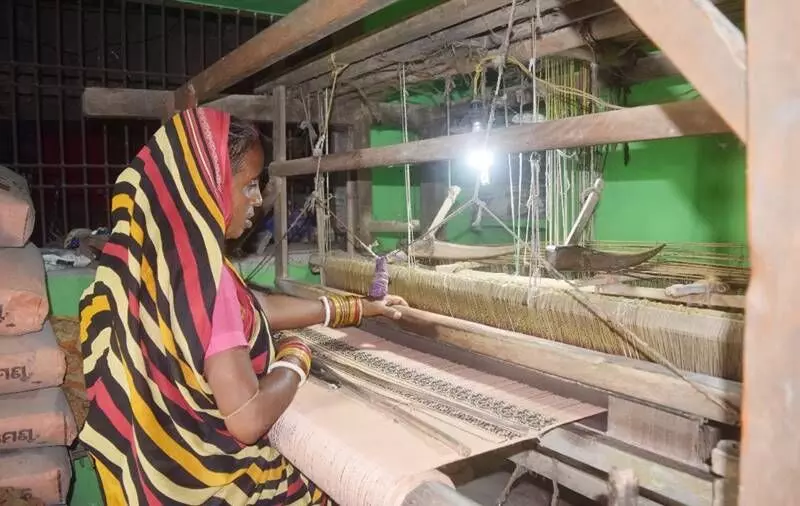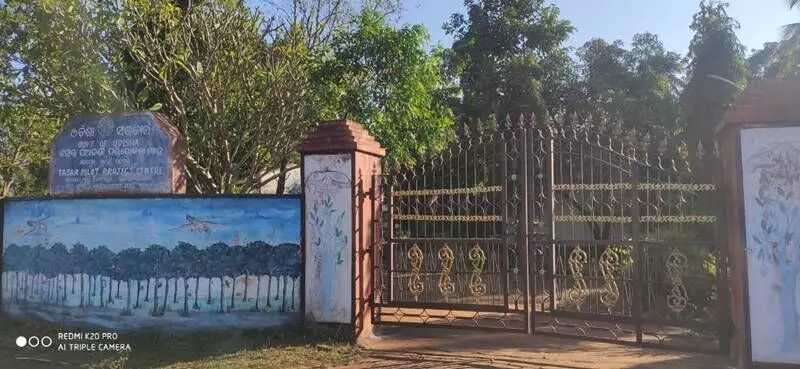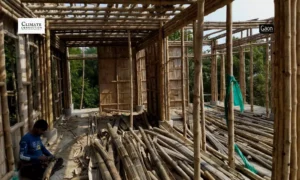Tussar silk sarees of Gopalpur village in Jajpur district are world famous due to the specialised weaving techniques adopted by the traditional weavers who have learnt this craft from their ancestors and are practising it for generations.
About 500 silk weavers in Gopalpur have been eking out their livelihoods by weaving tussar (also written as tasar) silk sarees, and the credit for this goes to the Tussar Pilot Project Centre at Mangalpur, said Narendra Kumar Behera, secretary of Balukeswaer Silk Weavers’ Cooperative Society of Gopalpur.
This Tussar Pilot Project Centre in Odisha’s Jajpur district is half-a-century old and in these five decades, it has helped a large number of silk weavers chart a journey to economic well-being.
In 2009, Gopalpur tussar also received a geographical indication (GI) tag from the Indian government making it extra special. This tag is a sign used on products that have a specific geographical origin and possess qualities or a reputation that are due to that origin.

In 2009, Gopalpur tussar also received a geographical indication (GI) tag from the Indian government making it extra special.
“We have been rearing silkworms or moths on Asan and Arjun trees spread over an area of 260 hectares at the centre. Farmers harvest around three lakh cocoons within three months from the centre and supply to silk weavers in Jajpur, Cuttack, Mayurbhanj, Keonjhar, Sundargarh, Dhenkanal and other districts of the state,” Achutananda Behera, Officer In-Charge of the Tussar Pilot Project Centre at Mangalpur, told Gaon Connection.
The official went on to inform that 250 farmers earn around one lakh rupees within three months by rearing silkworms and tussar cocoons at the centre. Meanwhile, weavers weave silk items from the cocoons, such as sarees, scarves, dupattas, etc, and sell them.
The centre rears silkworms or moths and supplies the cocoons to the weavers to weave tussar silk materials, and has provided local villagers with a sustainable source of income. It also trains them on new weaving techniques from time to time. The weavers are now demanding more native trees like Arjun and Asan in the forest for the rearing of the silkworms to further expand their business and increase their earnings.
Gopalpur’s weaving craft
Silk weaving in Gopalpur is at least seven centuries old. Some weavers from Burdwan district of West Bengal settled by the riverside Gopalpur to eke out their livelihood by weaving. Weaving is a skill that is done with utter brilliance and is passed on from generation to generation.
“Four decades back, we used to collect silkworms from the Asan and Arjun trees in the nearby forest. But now-a-days the forest department is planting water guzzling and fire prone eucalyptus trees in the name of afforestation, hence we now depend on the Mangalpur centre to get silkworms,” Benudhar Das, a weaver of Gopalpur, told Gaon Connection. “We need more Asan and Arjun trees in the forest to get silkworms and increase our earnings,” he added.
“A cocoon costs three rupees. A silk weaver needs 3,000 cocoons to weave a silk saree,” informed the officer in-charge Achutananda Behera. “Thrice in a year we collect cocoons. Weavers extract silk filament from cocoons by employing a set of processes known as silk reeling through chakras. For generations, sericulture and handloom weaving has remained a sustainable source of income for a large numbers of weavers in the state,” he said.

This Tussar Pilot Project Centre in Odisha’s Jajpur district is half-a-century old and in these five decades, it has helped a large number of silk weavers chart a journey to economic well-being.
Sericulture is an art of rearing silkworms for the production of cocoons, which is the raw material for the production of silk. The raw silk cannot be directly used for weaving on the looms.
Also Read: Tikuli Art of Bihar: From adorning women to empowering them
“We provide proper training to farmers and weavers to improve the tussar method and technology of silk rearing and weaving at the centre. At present around 250 farmers are rearing five lakh tussar food plants at the centre to harvest the tussar,” said Gobardhan Pradhan, secretary of Tussar Farmers’ Cooperative Societies at Sukinda.
We have been involved in silk weaving activities and earning our livelihood for many decades thanks to this centre, said Narendra Kumar Behera.
Promoting Gopalpur’s tussar silk
Efforts to promote the silk weavers of Gopalpur have gathered pace after senior officials of the textile department and the Odisha Rural Development and Marketing Society (ORMAS), among others, visited the village recently. “We are renewing our efforts to get the long-pending proposal of establishing a craft cluster in the village implemented,” said Surya Patnaik, Additional Director of Sericulture, Government of Odisha, told Gaon Connection.
Gopalpur, known for its tussar silk, has been proposed to be developed as a craft cluster under the Scheme of Fund for Upgradation and Regeneration of Traditional Industries (SFURTI). The SFURTI is an initiative by the Ministry of Ministry of Micro, Small and Medium Enterprises (MSMEs) to promote development in clusters.
“As part of the proposed project, we will set up four common facility centres (CFCs) in Gopalpur for creating sustained employment opportunities for the weavers. We will also plant more Arjun and Asan trees to help the silk weavers to get silkworms easily,” said Patnaik. “A detailed project report (DPR) will be prepared by the implementing agency with the help of the district administration,” the official added.




















